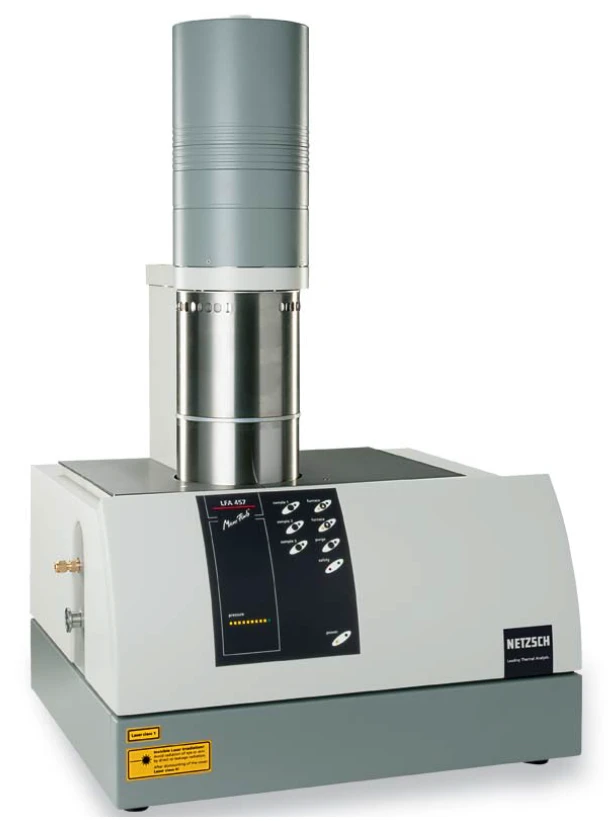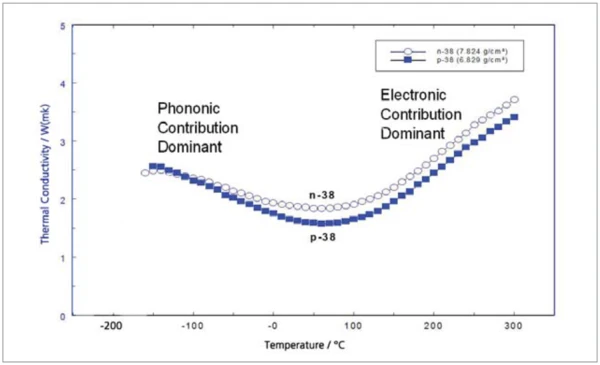Introduction
For thermoelectric applications, different materials such as bismuth telluride, plumb telluride and skutterudite are increasingly employed. For an economic use, for example, in automobiles or thermal power plants, high effi ciency of the thermoelectric systems is required. This is indicated by the so-called fi gure of merit (ZT). Along with a high Seebeck coefficient and high Electrical Conductivity (SBA)Electrical conductivity is a physical property indicating a material's ability to allow the transport of an electric charge.electrical conductivity, a low Thermal ConductivityThermal conductivity (λ with the unit W/(m•K)) describes the transport of energy – in the form of heat – through a body of mass as the result of a temperature gradient (see fig. 1). According to the second law of thermodynamics, heat always flows in the direction of the lower temperature.thermal conductivity is also required. The objective of the investigations is to reduce the phononic contribution and to increase the electronic contribution of the Thermal ConductivityThermal conductivity (λ with the unit W/(m•K)) describes the transport of energy – in the form of heat – through a body of mass as the result of a temperature gradient (see fig. 1). According to the second law of thermodynamics, heat always flows in the direction of the lower temperature.thermal conductivity. This can, for example, be realized by means of doping or establishment of structural conditions (targeted phonon scattering).
Experimental
The Thermal ConductivityThermal conductivity (λ with the unit W/(m•K)) describes the transport of energy – in the form of heat – through a body of mass as the result of a temperature gradient (see fig. 1). According to the second law of thermodynamics, heat always flows in the direction of the lower temperature.thermal conductivity measurements were carried out with the LFA 457 MicroFlash® (figure 1) on disk-shaped samples with a thickness of 2 to 3 mm and a diameter of 12.6 mm. The front surfaces of the samples were planeparallel.

Results and Discussion
Shown in figure 2 are the specifi c heat capacity, Thermal DiffusivityThermal diffusivity (a with the unit mm2/s) is a material-specific property for characterizing unsteady heat conduction. This value describes how quickly a material reacts to a change in temperature.thermal diffusivity and Thermal ConductivityThermal conductivity (λ with the unit W/(m•K)) describes the transport of energy – in the form of heat – through a body of mass as the result of a temperature gradient (see fig. 1). According to the second law of thermodynamics, heat always flows in the direction of the lower temperature.thermal conductivity of Bi0,5Sb1,5Te3 (P-38). The specific heat shows only a slight increase with increasing temperature. The Thermal DiffusivityThermal diffusivity (a with the unit mm2/s) is a material-specific property for characterizing unsteady heat conduction. This value describes how quickly a material reacts to a change in temperature.thermal diffusivity decreases in the lowtemperature range with increasing temperature and strongly increases at higher temperatures. At low temperatures, this corresponds to the behavior of a mere phononic conductor with the well-known 1/T dependence [1]. At higher temperatures, the contribution by the free electrons/holes which are increasingly formed in a semiconducting material with increasing temperature dominates. The Thermal ConductivityThermal conductivity (λ with the unit W/(m•K)) describes the transport of energy – in the form of heat – through a body of mass as the result of a temperature gradient (see fig. 1). According to the second law of thermodynamics, heat always flows in the direction of the lower temperature.thermal conductivity follows this trend due to the low temperature dependence of the Specific Heat Capacity (cp)Heat capacity is a material-specific physical quantity, determined by the amount of heat supplied to specimen, divided by the resulting temperature increase. The specific heat capacity is related to a unit mass of the specimen.specific heat capacity.

Figure 3 shows the comparison of the thermal conductivity of the p- and n-conducting layers P-38 (Bi0,5Sb1,5Te3) and N38 (Bi2Se0,2Te2,8). At -150°C, the thermal conductivity for both materials is approximately the same. Up to room temperature, the decrease in thermal conductivity of N-38 is lower compared to P-38. There is probably a stronger decrease in the phononic contribution of the thermal conductivity for P-38.
The increase in thermal conductivity at higher temperatures is approximately the same for both materials. It can therefore be concluded that the amount of the electron/hole contribution is the same for both materials. In both cases, a comparatively low thermal conductivity was determined. The strong increase at higher temperatures could refer to a high Electrical Conductivity (SBA)Electrical conductivity is a physical property indicating a material's ability to allow the transport of an electric charge.electrical conductivity, assuming a high figure of merit (ZT) for these materials.

Summary
A laser flash system was used for the investigation of the thermophysical properties of different thermoelectric materials. It could be demonstrated that the laser flash method is well-suited for optimization of thermoelectric materials (low lattice conductivity and high ZT values) and direct determination of the Thermal DiffusivityThermal diffusivity (a with the unit mm2/s) is a material-specific property for characterizing unsteady heat conduction. This value describes how quickly a material reacts to a change in temperature.thermal diffusivity, Specific Heat Capacity (cp)Heat capacity is a material-specific physical quantity, determined by the amount of heat supplied to specimen, divided by the resulting temperature increase. The specific heat capacity is related to a unit mass of the specimen.specific heat capacity and thermal conductivity. By means of the LFA 457 MicroFlash®, conclusions on the optimum structure and composition of thermoelectric materials can be drawn.